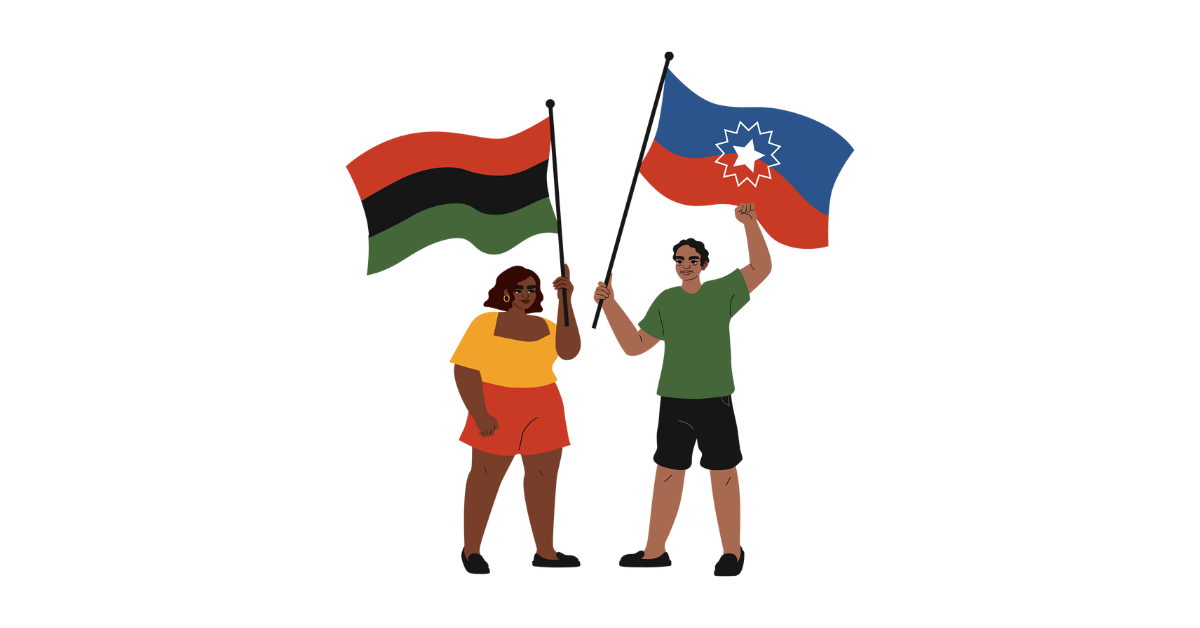Juneteenth is a federal holiday commemorating the true end of slavery in the United States. The observance is both a call to remembrance as well as a celebration of Black identity, culture, and community. For organizations wondering how to celebrate Juneteenth at work, both of these aspects of Juneteenth — remembrance and celebration — are important.
Juneteenth festivities are an opportunity to reflect on the United States’ racist past and present while working towards a future built on social and racial justice. Commemorations of Juneteenth in the workplace should incorporate education, community involvement, and Diversity, Equity, Inclusion, and Belonging (DEIB) workplace policies. These elements not only send a message of support externally but, more importantly, they can help companies look inward to ensure they’re supporting Black employees and candidates.
In this article, we'll cover:
- What is Juneteenth?
- Why is Juneteenth important?
- How to celebrate Juneteenth at work
- Juneteenth celebration events and resources
What is Juneteenth?
Juneteenth is a portmanteau of “June” and “nineteenth, the day in 1865 when the last enslaved Black people in the U.S. gained their freedom from slavery. Slavery in the U.S. had technically – emphasis on technically — ended more than two years earlier when, on January 1, 1863, President Abraham Lincoln issued the Emancipation Proclamation. It was an edict that Confederate-controlled states ignored. After the Civil war ended on April 9th, 1865, Union forces announced that all enslaved people in Confederate states were free — but even then, not all traffickers of enslaved people obeyed, and many enslavers purposely kept enslaved Black people from knowing about their new rights and protected status. On June 19th, 1865, 2,000 Union troops marched into Galveston, Texas, to enforce those rights, declaring freedom for the state’s approximately 250,000 still-enslaved Black people.
The illegal continuation of slavery was the case in multiple places beyond just Galveston, Texas. True emancipation occurred on different dates in places across the U.S., so the dates of early emancipation celebrations varied for cities and states like:.
- Washington D.C.: April 16, 1862
- Ohio: September 22, 1862
- Galveston, Texas: June 19, 1865
As the date that the final holdout against freedom ended, Juneteenth became the date chosen for celebrations that would go on to grow in size and popularity. Eventually, Juneteenth became the most widely recognized emancipation celebration in the U.S. The date was finally enshrined as a federal holiday in 2021.
Why is Juneteenth important?
Juneteenth celebration events are a commemoration of the end of slavery in the U.S. and the arrival of freedom for Black communities. With Juneteenth, we remember that slavery was an official institution of the U.S. for over 200 hundred years, and that it:
- Enslaved over 10 million people in the U.S. in that time
- Forced 410 billion hours of labor in inhuman conditions
- Was used to drive the No. 1 U.S. export: cotton
Juneteenth allows us to reflect on our national past, come together in community, and celebrate freedom for all people. Importantly, Juneteenth is also a continued protest and call to action for our present and future. Although chattel slavery was abolished, racism, inequality, and oppression very much remain for Black individuals and communities.
How to celebrate Juneteenth at work
For organizations looking to celebrate Junteenth in the workplace, there are plenty of engaging and thoughtful Juneteenth activities for adults. Just remember that while the day itself may center fun and celebration, that needs to be paired with DEIB policies and ongoing initiatives that demonstrate your intentional (and not performative) support for the Black community. In other words, without doing a thorough policy review for unfair hiring and promotions; without conducting a pay audit (more on that below); without culling diverse slates of candidates for open roles; and without helping Black employees advance to leadership positions (and ensuring they're not pushed off the "glass cliff" while doing it), celebrating Juneteenth isn't enough.
All of that said, here are some ideas for Juneteenth celebrations at your workplace.
1. Educational sessions
Museum outing. Who doesn’t love a field trip? Your city or town likely has a museum or center that focuses on Black history. Organize a trip during work hours to a museum and cover the entrance fee for all participating employees. If the museum is free, make a public contribution to show your support.
A guest speaker. Invite (and financially compensate) an expert from the Black community to speak on a relevant issue. Topics could be the history of Juneteenth, Black joy, Black mental health, raising anti-racist children, and more. If you have a Black ERG, this is a great opportunity for them to find and support an expert from the community. For geographically dispersed teams, the talk can be available virtually, as well.
Register for our virtual Juneteenth Chat & Learn
2. Get involved in the Black community
Get in the parade. It’s likely that there’s a public or community-based Juneteenth celebration happening in your area. These are often parades or festivals. Get involved in these celebrations by paying for a booth at the festival or a float in the parade.
Organize a cookout. One of the ways many Black people celebrate Juneteenth is with a barbeque. Hire a local Black-owned restaurant to cater an outdoor barbeque during work hours. Ask your Black ERG to invite local organizations, leaders, or community members to attend your Juneteenth cookout.
3. Donate to and sponsor Black causes
Match employee giving. For Juneteenth, ask your Black ERG to select one or two causes to support. Ask employees to donate and then match their donations, dollar for dollar.
4. Support your Black employees
Survey your Black employees. A common complaint is that companies claim to support Black causes on social media while doing little internally to support Black workers. Survey your Black employees and ask them how they feel the company is doing on diversity, equity, inclusion, and belonging.
Conduct a pay audit. A pay audit lets you identify wage disparities among your employees. In the U.S., Black women make 63 cents for every dollar paid to a White man. You’ll need to gather a lot of data, which includes racial demographic data, so having dedicated DEIB software helps. Identify if pay gaps exist and whether or not they can be explained.
5. Decorate the office
Decorate the office with Juneteenth colors: red, blue, black, and green. The Juneteenth flag was created in 1997 by Ben Haith, founder of the National Juneteenth Celebration Foundation. The flag is red and blue, with a white starburst in the middle. Another flag used on Juneteenth is the Pan-African flag, with three horizontal stripes of red, black, and green. This flag was created in 1920 as a symbol of pride and political power for Black Americans.
6. Things to avoid
Avoid empty social media posts. External words of support on social media come off as disingenuous when companies fail to make changes internally. Where are you on your DEIB journey? How are you supporting your Black employees? These questions should be the focus of your efforts and messaging.
Don’t ask your Black employees for free work. If you’re asking your Black employees or ERG to do extra work, make sure you give them resources to hire Black-owned businesses or to bring in outside event planning or educational support. Better yet, compensate your employees directly.
Juneteenth celebration events and resources
These ideas for a Juneteenth celebration at work, combined with participating in existing community celebrations, offer some good pointers for commemorating the holiday.
Speaking of community celebrations, there are events across the country. Check out what’s planned in Oakland, Los Angeles, Denver, Chicago, Minneapolis, New Orleans, Columbus, New York, and Washington D.C. for more info.
Here are some additional resources and guides on how to celebrate Juneteenth at work:
- Juneteenth Digital toolkit - National Museum of African American History and Culture
- Interactive timeline of African American history - University of California Berkeley
- Education resources for teaching Juneteenth - Teaching Expertise
- The impact of slavery today - UC Berkeley
And here are some additional resources for supporting Black talent year-round:
- Watch: Unlocking Black Potential: Strategies for Amplifying Black Excellence in Leadership and Education
- Watch: The ROI of DEI: Meaningful DEI Training
- Watch: Being an Ally to Black Colleagues and Peers
- Watch: Increasing the Black Footprint in Tech: How to Create a Safe Space for Black Employees
- Watch: Supporting Black Trans & Nonbinary People in the Workplace and Beyond
- Watch: Where Are the Black Women CEOs?
How to celebrate Juneteenth at work? Joy, remembrance, change
Juneteenth is a time for the nation to celebrate the true end of slavery, reflect on its impact, and work towards a better future. For companies searching for how to celebrate Juneteenth at work, a look inward is the starting point. How are your Black employees feeling? Are they being paid equitably? How connected to the Black community is your company? Juneteenth is the perfect opportunity to ensure that your DEIB work is making a difference for Black employees.Diverse teams perform better. Let PowerToFly help you build yours.




